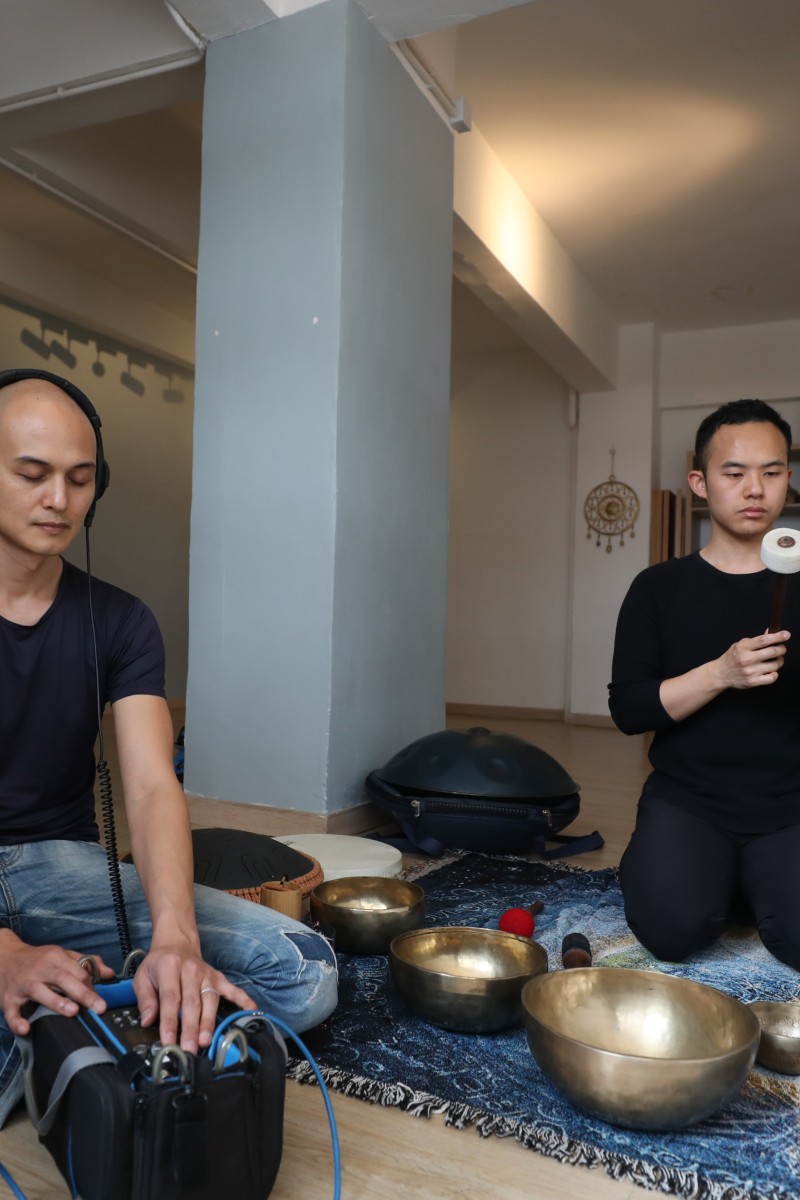
Study Buddy (Challenger): Live recordings draw listeners into sound bath communities in Hong Kong and Asia
- Terence Lloren, founder of Sound Bath Sessions, hopes to share intimate ‘sound portraits’ that capture the communities that practitioners are rooted in
- This page is for students who want to take their reading comprehension to the next level with difficult vocabulary and questions to test their inference skills
 Sound recordist Terence Lloren (left) and sound bath practitioner Calvin Chan record the deep vibrations created by instruments such as singing bowls. Photo: Xiaomei Chen
Sound recordist Terence Lloren (left) and sound bath practitioner Calvin Chan record the deep vibrations created by instruments such as singing bowls. Photo: Xiaomei ChenContent provided by British Council
Read the following text, and answer questions 1-9 below:
[1] Terence Lloren is a sound recordist, so it should come as no surprise that he has a sharp sense of hearing. But when he experienced his first sound bath – a meditative practice that immerses people in deep sound vibrations created by instruments such as gongs and singing bowls – it blew his mind. “It’s amazing how gong practitioners start with a blank canvas and paint something right in front of you with sound,” said Lloren, a Filipino-American who recently moved to Hong Kong after 16 years in Shanghai.
[2] Lloren said his first gong session, conducted by Hong Kong practitioner Martha Collard, the founder of Red Doors Studio, was an emotional one. “I listen to sound very openly and take in a lot of it and process it like information,” said Lloren, who in 2009 founded the sound label Bivouac Recording. “It’s like seeing with my ears. With this gong bath, there was so much sound and so much information that I couldn’t believe it – I thought my mind was going to explode,” he shared, adding that the experience had him both smiling and tearing up.
[3] Hooked, Lloren – who is also a trained architect – was determined to document and share these sounds while drawing attention to the sound bath community. And that is how Sound Bath Sessions – a subscription-based collection of live recordings of sound baths from practitioners in Hong Kong and elsewhere in Asia – was born.
[4] “While researching this project, I found plenty of sound baths on media platforms and apps, but they were generic, not localised, and had no community surrounding them,” he explained. “I met with new local practitioners with their exotic handmade instruments, and more mature practitioners who were deeply rooted in their communities and masters of their craft.”
[5] One common ambition they held was to use sound and meditation to help with mental and physical health and promote general well-being. “It was a shame that none of these people were properly represented in the medium that they wholeheartedly believed in and so passionately worked with,” Lloren noted, adding that any money made from Sound Bath Sessions was split evenly between himself, the practitioners and a chosen charity. “This is not a moneymaking machine.”
[6] He added that the recordings were intimate, candid “sound portraits” documenting not just the sound baths but other noises heard in a typical session. “I also wanted to capture the sounds of Hong Kong, like the traffic out the window, people talking in the hall, or the sound of an elevator,” Lloren said. “Sometimes, while editing, I would fall asleep or go into a trance and forget what I’m doing,” he laughed. “I’m supposed to be listening for anomalies, but in reality, I’m floating in my own thoughts.”
[7] While some refer to sound bathing as a healing therapy, there is no scientific evidence that it can heal a medical condition. A growing body of research, however, has shown benefits including deeper relaxation, stress relief and improved sleep. The recordings, Lloren said, could be used for meditative purposes or entertainment. What he wants to make clear is that he is not taking business away from sound therapists. “If people want to experience the true powers of a sound bath, they have to go to a session in person and feel the physical vibrations.”
Source: South China Morning Post, April 28
Questions
1. According to paragraph 1, Lloren has a ______ sense of hearing.
A. capable
B. keen
C. effectual
D. harsh
2. What happens during a sound bath session according to paragraph 1?
3. Find a phrase in paragraph 1 that meant Lloren found his first sound bath experience “unusual and exciting”.
4. Which of the following best describes his first sound bath session?
A. sentimental
B. disturbing
C. hysterical
D. none of the above
5. According to paragraph 3, what does Lloren hope to achieve with Sound Bath Sessions?
6. What can people expect when they subscribe to Sound Bath Sessions?
7. What is lacking in the sound baths on various media platforms according to Lloren in paragraph 4? (2 marks)
8. According to paragraph 6, how are the recordings in Sound Bath Sessions different to those found elsewhere?
9. Why might a health professional be sceptical of using sound bathing as a healing therapy?
Answers
1. B
2. A person is immersed in deep sound vibrations created by instruments such as gongs and singing bowls.
3. blew his mind
4. D
5. He wants to document and share sound baths while also promoting the practitioners and wider community behind them.
6. A collection of live recordings of sound baths from practitioners in Hong Kong and Asia.
7. They were too generic and were not rooted in any local community or culture. (accept similar answers)
8. They capture the sounds of Hong Kong, like the traffic out the window, people talking in the hall, or the sound of an elevator.
9. It is because there is no scientific evidence that it can heal a medical condition.
